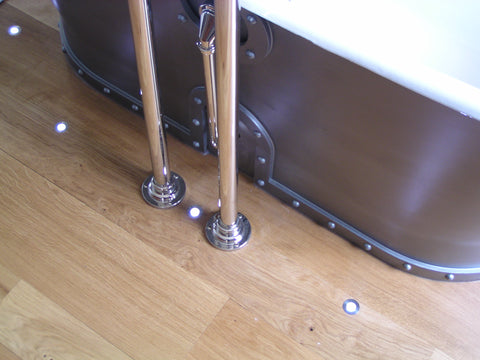
Bathroom Lighting
Bathroom lighting needs to be both sufficient and clear for tasks such as make up or shaving and gentle and unobtrusive for general bathing and relaxation.
Too much bright light in a bathroom will be far from relaxing whilst insufficient light by a mirror is not ideal for specific tasks.
As with most rooms, the light can be layered and it should be possible to make use of the ceiling, walls and floor as well as more discrete lighting within shelves or alcoves.
Before considering lighting in detail, the bathroom being a wet or damp space, there are regulations concerning electrical appliances within the bathroom and their proximity to water.
Bathrooms have four Zones and the placing of electrical equipment within these zones will depend upon the IP rating or protection rating of that piece of equipment from water ingress. (Details of zoning within the bathroom are included at the end of this article.)

Having understood the regulatory requirements we can turn to how best to light the bathroom.
As with any room, there are three areas into which lighting can be installed - ceiling, walls and floor. There are also discreet locations such as cabinet lighting and strip lighting within mirrors or edge lighting to shelves.
Outside the scope of this article is natural light, although this too is an important lighting element. However, the use of natural light may be dictated by the need for privacy and the use of curtains, screens or blinds that will affect the amount and quality of the light within the space.
For general lighting, ceiling downlights are the most effective solution but the glare must be controlled if they are to be comfortable for the user. Dimming also helps as it adds atmosphere especially when trying to relax in the bath. If height is sufficient, a dropped false ceiling with perimeter edge lighting will give soft non directional light and will be glare free. Dropped ceilings have other uses as they can be used for fan ducts over showers and baths to remove damp air.

Bathroom by Nicholas Sutherland Interiors
In bathrooms with hard floors the installation of floor lights is an interesting way to light the space. This can either be with linear strip lighting to graze walls with light or with in ground uplights. Uplights can provide substantial light or be markers - pin dots of light say around the bathtub.
As with downlights, glare should be mitigated wherever possible.
If it is not possible to fit uplights, rechargeable floor standing lanterns can be an excellent solution with the added benefit of being portable.

Whilst a bathroom can be lit entirely from the ceiling or the floor without the need for wall lights, there is however, a need for good, even light at a mirror over the wash basin. Ideally lighting should be on two sides of the mirror to avoid harsh shadows and this is particularly important for make up. Mirrors can now be fitted with strip lighting or the lights can be applied as external fittings to the mirror or the walls adjacent to the mirror.
A useful addition, although not to everyones taste, is the illuminated magnifying mirror which being adjustable, is a practical solution where the client requires excellent light at or near the wash basin.

In this article I have dealt with what is essentially a modern approach to the problem of lighting the bathroom.
There are many bathrooms in older houses where for one reason or another much of what is proposed here may be neither technically possible nor desirable as in the wonderful bathroom below by the late David Hicks in which the decoration takes centre stage and the lighting appears little more than incidental to the scheme.

Bathroom by David Hicks
As with all rooms, the architecture, layout and decoration should determine the correct approach to lighting. Lighting should not dominate but enhance the design and desired look of the room.
There is no right way to light the bathroom but then there may be a myriad of wrong ways to do it. By applying the regulatory rules and allowing the layout and decoration to control the decisions the right approach should emerge.
Links -
Betec Leuchten
Baulmann Leuchten
Zoning Requirements Within the Bathroom

Zone 0 Lighting in this zone must be rated at IP67 or IP68 which implies that the fitting can be submerged within the bath or shower in the same way under water lighting is installed within a swimming pool.
Zone 1 This is the area above the bath to a height of 2.25m from the floor or within the shower enclosure. If the fitting is 240V a 30ma residual current device (RCD) must also be used to protect the circuit in this zone and fittings with an IP65 rating should be used.
Zone 2 This is an area up to 600mm outside the perimeter of the bath or shower enclosure and to a height of 2.25m from the floor. In these bathroom zones any light fittings should be rated to IP44. In addition, it is good practice to consider the area around a wash basin, within a 60cm radius of any tap, to be considered as zone 2. The immediate area around a wash basin, within a radius of 600mm of the taps should also be considered as Zone 2.
Zone 3 This is anywhere outside Zones 0, 1, and 2 (subject to specific limits) and where no water jet is likely to be used. Whilst there is no requirement to use an IP rated fitting, good practice suggests that you might use the same standard as in Zone 2 ie IP44. However, if there is a likelihood of water jets being used for cleaning purposes in Zones 1, 2 and 3, a fitting rated a minimum IP65 must be used.









